
From the Dinosaur Collector
The Early Permian fauna was tied to the wetter equatorial region. Amphibians remain common. The Permian is the last phase of the Paleozoic and plant life is very different. Tree ferns, the relatives of Cattails and Club Mosses characterize flora the period most died out leaving no living representatives. Ferns are present but they are not closely connected to any modern families. The dry highlands away from the swamps is where future of both the animal and plant life is evolving. updated 050505
Dimetrodon was wide spread and and represents a significant portion of the fauna in most environments. Since the proportion of population is so high it seems unlikely to have been warm blooded. In modern warm blooded populations predators represent 3 - 5% of fauna where as Dimetrodon represents 40 - 50% of most faunas much as you would expect to see in a cold blooded fauna. There has been a great deal of speculation that the sail could have served as a means of regulating temperature. That it developed as a display device seems to be a simpler explanation since so many of its relatives lacked a sail and seem to have done very well.

Retired Carnegie Safari Dimetrodon 1/40 scale. On the right the Safari Habitat Dimetrodon. The giant Club Moss on the back right and left was sent by Steve Barber from his prehistoric plants RPG series. The base was cast and donated by Mike Evans of Alchemy Works and is from the Zallinger Permian diorama.
Williams Ranch Texas was a dry floodplain in the Permian. ?Dimetrodon's prey was the plant eater Diadectes. ?Diadectes was either an advanced amphibian or an early reptile. Land based plant eaters really haven't gotten established yet. Dimetrodon clearly dominates the fossil record here.? It was long thought that reptiles evolved from amphibians, but it was hard to come up with actual evidence. A transitional fossil species called Seymoria was discovered, and this is actually one of the best transitional fossils on record. It has mixtures between amphibians and reptiles so complete, it is very difficult to classify as one or the other.
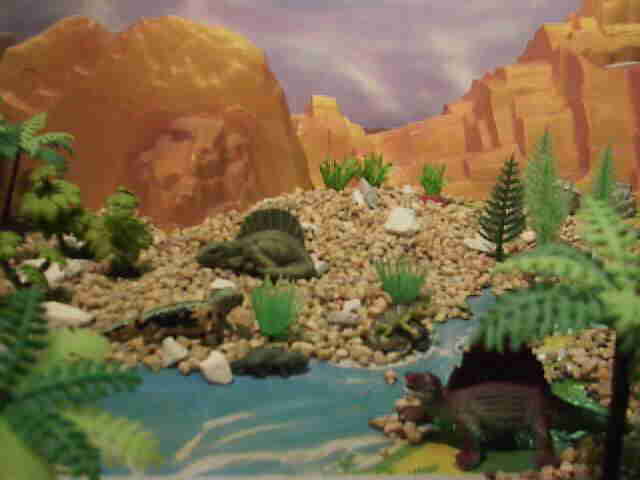
Front right is the Starlux Dimetrodon. ?The Hallmark resin Dimetrodon is resting. ?The plant eater Diadecties is represented by the iguana figure. The Timmee Seymoria is the small figure at the water edge. This is a petty obscure animal and only included in the mini line.
The Labyrinthodonts were the first amphibians to be fully adapted to living on land. Their hey days were Carboniferous Period , called the Age of Amphibians and the Permian Period. ? They are the main prey for Dimetrodon at Black Flat Texas then a series of small ponds. ?When the dinosaurs appear in the Triassic giant amphibians start to disappear but some of them last on until the Cretaceous. Dimetrodon is clearly the top predator here and very numerous. ? ?

Bullyland Dimetrodon from their small and medium series. ?An Eryops from Deiner and a PlayVision Eryops.
Dimetrodon grandis is the largest and best known of the Dimetrodons. Eryops was a large fish eating amphibian that probably filled the role of alligators.

The two versions of the Kaiyodo Dinotales series 1 Dimetrodon and the series 5 Eryops.
The Geraldine Bone Bed is an unusual quarry in Texas that represents a of a stagnant backwater, a fetid swamp where rotting vegetation chokes the river channel. ?The plant eater Edaphosaurus is common with only small juvenile Dimetrodon's present. This seems to be one of the few places Dimetrodon didn't dominate which may be why Edaphosaurus survived here. Toting around the large sail would have been easier in open environments. ????
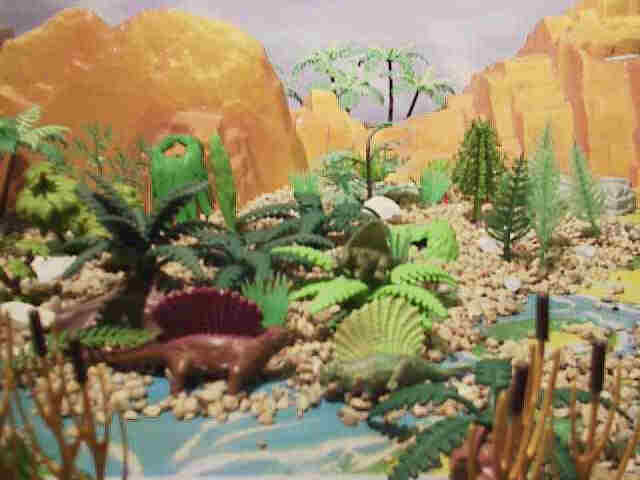
Small Dimetrodon from Bullyland. ?Edaphasaurus from Starlux and Deiner. The Deiner figure is from a set of erasures but is very detailed note that the spines have the small cross sections along them. This is quit different from its distant relative Dimetrodon.
At Rattlesnake Canyon an ancient lake shore the fish eater Ophiacodon was a Dimetrodon main meal.? Ophiacodon was a primitive pelycosaur which appears to have developed an amphibious lifestyle.

Dimetrodon from the discontinued Carnegie Safari up front and walking forward the Safari Habitat version. ?At the waters edge is a Panosh series Ophiacodon. Like all Panosh figures this is unnamed but I think it a good guess. The green Lycopod is from the Aurora Swamp diorama model.
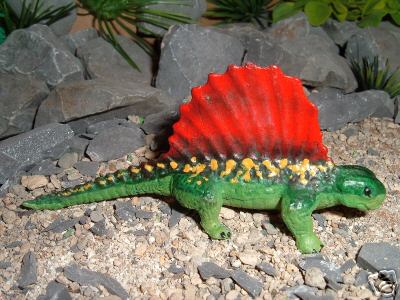
Recast Marx Dimetrodon custom painted by Fred R. Hinojosa.
Sphenacodon ferocior was about 225 cm. long and is thought to have weighed 129 kg. A close relative of Dimetrodon it is thought to have lived in the forested areas where a sail would have been awkward. It had long vertebrae but no fin.
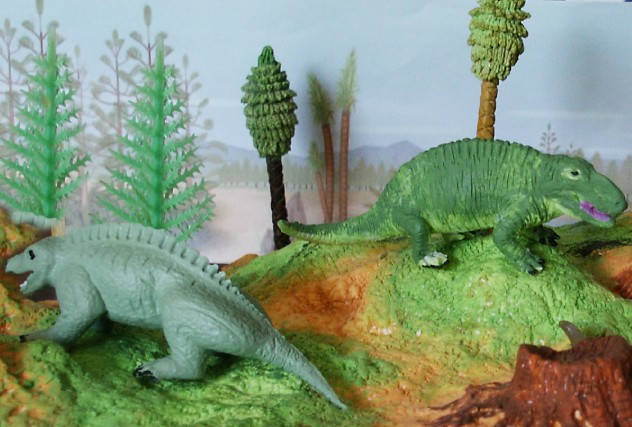
Left is a Marx Sphenacodon with high lights added. Right is a resin figure from Zallinger Diorama model donated by Mike Evan. Sphenacodon doesn't show up often in contemporary play sets.
Sphenacodon ferox was somewhat smaller and apparently more common Varanosaurus was another pelycosaur relative without a sail and would have looked superficially like a modern monitor lizard.
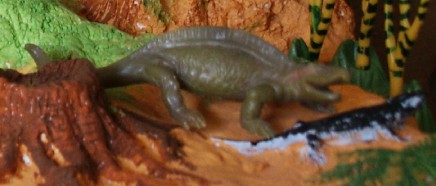
Linde Sphenacodon premium originally from an Austrian coffee company. Varanosaurus courtesy of Alchemy works.
click on this link for more about Dimetrodon and Permian Amphibians
return to Paleozoic menu
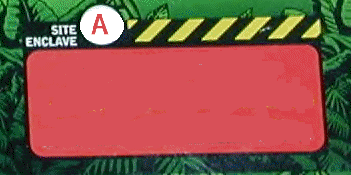
 Click on the Site A icon left for more diorama listed
by location Click on the Site A icon to the right for Dioramas organized by
period or by manufacturer.
Click on the Site A icon left for more diorama listed
by location Click on the Site A icon to the right for Dioramas organized by
period or by manufacturer.